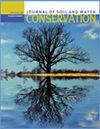Restoring South Asia’s degraded soils and ecosystems for peace and prosperity
IF 2.6
4区 农林科学
Q2 ECOLOGY
引用次数: 0
Abstract
S outh Asia (SA), a subcontinent, is the world's most densely populated region. It consists of nine countries: Afghanistan, Bangladesh, Bhutan, India, Iran, Maldives, Nepal, Pakistan, and Sri Lanka (figure 1). Myanmar and Tibet are also sometimes included in the SA region but won’t be included in this article. SA is a region with common geography, history, culture, language, and religions. The SA region has the world’s highest mountain ecosystem, the Himalayas, also called the Third Pole (Chaudhary et al. 2023). It also faces serious challenges of ecological degradation, which transcend beyond political boundaries and jeopardize global peace and political stability. Important among these issues are climate change, food and nutrition insecurity, soil degradation/pollution along with extinct/endangered and peak soils, water scarcity, and eutrophication, which exacerbate the flood-drought syndrome. The latter is aggravated by denudation of the landscape, excessive grazing, and deforestation of ecologically sensitive ecoregions. Additionally, pollution of air quality is aggravated by in-field burning of crop residues and attendant emission of soot and greenhouse gases, which create positive feedbacks to global warming. Ecological degradation in SA, a complex issue, is driven by a wide range of interacting factors, including rapid population growth, urbanization, industrialization, rapid deforestation, economic growth, poverty, and a high dependence on natural resources (Sultana et al. 2022; EFSAS 2021; Chaudhary et al. 2023; Ajmal 2023). These degradation processes perpetuate the threats of undernutrition and malnutrition as well as decline in human health and well-being to a large proportion of the population. They also increase risks of political instability, civil strife, soil/climate refugees, and war among nations of the SA region (figure 2). Indeed, soil and ecological degradation is the common enemy of Rattan Lal is a distinguished university professor of soil science and is director of the CFAES Rattan Lal Center for Carbon Management and Sequestration, The Ohio State University, Columbus, Ohio. Received March 27, 2023. all countries in SA, and they must cooperate, work together, and effectively address this menace. Thus, the objective of this article is to describe the common and hideous enemy of SA: soil and ecological degradation with its cascading adverse effects leading to human suffering; poverty; environmental pollution; global warming; political instability at local, regional, and global levels; and hostilities among neighboring countries. The specific hypothesis of the article is that restoring degraded soils and the polluted environment is critical to achieving human well-being and accomplishing lasting peace and harmony in SA.恢复南亚退化的土壤和生态系统,促进和平与繁荣
南亚(SA)是一个次大陆,是世界上人口最稠密的地区。它由9个国家组成:阿富汗、孟加拉国、不丹、印度、伊朗、马尔代夫、尼泊尔、巴基斯坦和斯里兰卡(图1)。缅甸和西藏有时也被包括在南亚地区,但本文不包括在内。SA是一个拥有共同地理、历史、文化、语言和宗教的地区。南亚地区拥有世界上最高的山地生态系统,喜马拉雅山,也被称为第三极(Chaudhary et al. 2023)。中国还面临着超越政治边界、危及世界和平与政治稳定的生态退化的严峻挑战。其中重要的问题是气候变化、粮食和营养不安全、土壤退化/污染以及已灭绝/濒危和峰值土壤、水资源短缺和富营养化,这些问题加剧了水旱综合征。后者因景观的剥蚀、过度放牧和生态敏感地区的森林砍伐而加剧。此外,农田内焚烧农作物秸秆以及随之而来的烟尘和温室气体排放加剧了空气质量污染,这对全球变暖产生了正反馈。南亚的生态退化是一个复杂的问题,受到多种相互作用因素的驱动,包括人口快速增长、城市化、工业化、快速砍伐森林、经济增长、贫困和对自然资源的高度依赖(Sultana et al. 2022;欧洲食品安全署2021;Chaudhary et al. 2023;Ajmal 2023)。这些退化过程使营养不足和营养不良的威胁持续存在,并使很大一部分人口的健康和福祉下降。它们还增加了政治不稳定、内乱、土壤/气候难民和SA地区国家之间战争的风险(图2)。事实上,土壤和生态退化是Rattan Lal的共同敌人。Rattan Lal是俄亥俄州哥伦布市俄亥俄州立大学著名的土壤科学教授,也是CFAES Rattan Lal碳管理和碳吸收中心的主任。收于2023年3月27日。南非所有国家,他们必须合作,共同努力,有效地应对这一威胁。因此,本文的目的是描述森林退化的共同和可怕的敌人:土壤和生态退化及其连锁反应导致人类苦难;贫困;环境污染;全球变暖;地方、区域和全球各级的政治不稳定;邻国之间的敌对。文章的具体假设是,恢复退化的土壤和污染的环境对于实现人类福祉和实现SA的持久和平与和谐至关重要。
本文章由计算机程序翻译,如有差异,请以英文原文为准。
求助全文
约1分钟内获得全文
求助全文
来源期刊
CiteScore
4.10
自引率
2.60%
发文量
0
审稿时长
3.3 months
期刊介绍:
The Journal of Soil and Water Conservation (JSWC) is a multidisciplinary journal of natural resource conservation research, practice, policy, and perspectives. The journal has two sections: the A Section containing various departments and features, and the Research Section containing peer-reviewed research papers.

 求助内容:
求助内容: 应助结果提醒方式:
应助结果提醒方式:


